Rivers are dynamic natural waterways that shape landscapes, support diverse ecosystems, and provide vital resources for human communities. They contribute to agriculture, transportation, and recreation while playing a crucial role in maintaining environmental balance. Discover how rivers impact your world and why they deserve your attention in the rest of this article.
Table of Comparison
| Feature | River | Strait |
|---|---|---|
| Definition | Natural freshwater flowing body connecting inland areas to oceans or lakes | Narrow saltwater channel connecting two larger bodies of water |
| Water Type | Freshwater | Saltwater |
| Location | Flows across land through valleys or plains | Located between two land masses, linking seas or oceans |
| Length | Can vary from a few kilometers to thousands of kilometers (e.g., Nile River: 6,650 km) | Usually shorter; varies based on geographic context (e.g., Strait of Gibraltar: 13.7 km width) |
| Purpose | Supports freshwater ecosystems, irrigation, transportation | Facilitates marine navigation and water exchange between seas |
| Examples | Amazon River, Mississippi River, Yangtze River | Bering Strait, Strait of Gibraltar, Bosporus Strait |
Introduction to Rivers and Straits
Rivers are natural freshwater waterways flowing from higher to lower elevations, often originating from springs, glaciers, or rain, and serving as vital sources for ecosystems, agriculture, and human consumption. Straits are narrow saltwater channels connecting two larger bodies of water, such as seas or oceans, and act as crucial maritime routes for shipping and biodiversity exchange. Both rivers and straits play essential roles in geography, navigation, and environmental systems worldwide.
Defining Rivers: Key Characteristics
Rivers are natural freshwater watercourses flowing continuously or seasonally across land, originating from sources such as springs, glaciers, or rainfall accumulation. They exhibit distinct characteristics including a defined channel, flow direction from higher to lower elevation, and the capacity to shape landscapes through erosion and sediment transport. Unlike straits, rivers primarily discharge freshwater into larger bodies of water such as lakes, seas, or oceans, serving as critical ecosystems and freshwater resources.
Understanding Straits: Main Features
Straits are narrow, naturally formed waterways connecting two larger bodies of water, often facilitating significant marine traffic and ecological exchange. Unlike rivers, which flow from higher to lower elevations within a continuous channel, straits are tidal passages influenced by ocean currents and salinity gradients. Key features of straits include their strategic geopolitical importance, complex hydrodynamics, and diverse marine ecosystems shaped by the interaction of adjacent seas or oceans.
Geographical Formation: Rivers vs Straits
Rivers are freshwater bodies flowing from higher elevations to lower areas, formed by precipitation runoff and groundwater discharge, carving valleys and shaping landscapes through erosion and sediment deposition. Straits are narrow, naturally occurring saltwater channels connecting two larger bodies of water, created by tectonic activity, sea level changes, or glacial erosion, often serving as critical maritime passages. The main geographical distinction lies in rivers being fluvial features transporting freshwater across continents, while straits function as marine passages influencing ocean currents and biogeographic exchanges.
Ecological Significance of Rivers and Straits
Rivers support diverse freshwater ecosystems by providing critical habitats for numerous aquatic species and facilitating nutrient cycling essential for maintaining biodiversity. Straits serve as unique marine corridors that influence water salinity, temperature, and nutrient exchange, supporting rich and productive ecosystems with high species variability. Both rivers and straits play vital roles in ecological connectivity, promoting migration and genetic exchange among aquatic populations.
Economic Importance: Transportation and Trade
Rivers serve as natural inland waterways that facilitate the transportation of goods and raw materials, significantly reducing shipping costs and boosting regional trade economies. Straits are strategic maritime passages connecting major seas or oceans, enabling international shipping routes that handle a substantial portion of global trade. Control and access to key straits, such as the Strait of Hormuz or Malacca Strait, are critical for securing energy supplies and maintaining global commerce flow.
Biodiversity Comparison: River vs Strait
Rivers typically support high biodiversity with freshwater species such as fish, amphibians, and macroinvertebrates adapting to flowing water and varying sediment levels, while straits, as narrow marine passages connecting large bodies of saltwater, host diverse marine life including migratory fish, marine mammals, and coral communities. The dynamic flow and nutrient exchange in straits create rich habitats for plankton and benthic species, enabling complex food webs distinct from freshwater ecosystems found in rivers. Differences in salinity, water temperature, and flow regimes between rivers and straits significantly influence species composition and ecosystem productivity.
Major Examples Around the World
The Nile River in Africa and the Amazon River in South America stand as the world's longest and most voluminous rivers, crucial for their ecosystems and human settlements. The Strait of Gibraltar, connecting the Atlantic Ocean and the Mediterranean Sea, and the Bosporus Strait in Turkey, linking the Black Sea to the Sea of Marmara, are essential maritime chokepoints with significant strategic and economic importance. Rivers primarily serve as freshwater sources and inland transportation routes, whereas straits function as narrow sea passages facilitating international shipping and naval passage between larger bodies of water.
Human Activities and Environmental Impact
Rivers serve as crucial freshwater sources for agriculture, transportation, and urban development, but face pollution and habitat disruption from industrial runoff and dam construction. Straits, vital for global maritime trade and fisheries, experience environmental stress from shipping traffic, oil spills, and invasive species introduction. Both ecosystems require sustainable management to balance human economic activities with the preservation of biodiversity and water quality.
Conclusion: Key Differences and Similarities
Rivers are freshwater bodies that flow from higher elevations to lower areas, typically emptying into seas or lakes, while straits are narrow saltwater channels connecting two larger bodies of water. Both rivers and straits play crucial roles in ecosystems and human navigation, yet rivers primarily support freshwater habitats and sediment transport, whereas straits influence marine water exchange and tidal flows. Understanding these distinctions emphasizes their importance in hydrology, geography, and environmental science.
River Infographic

 libterm.com
libterm.com